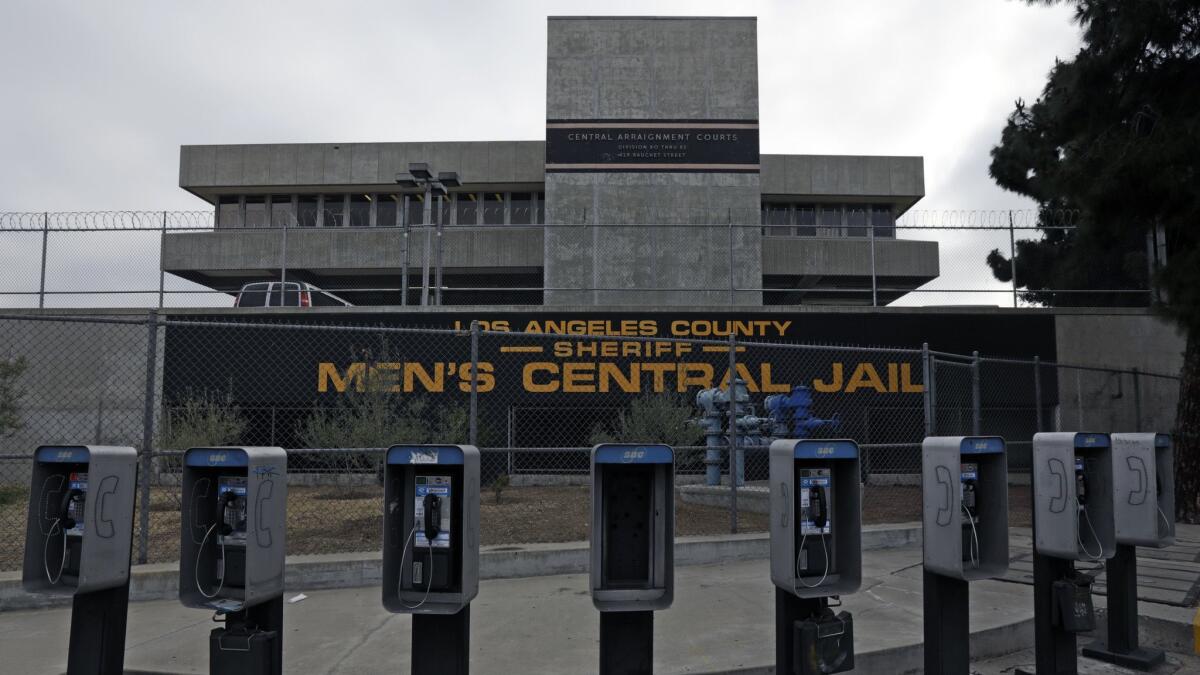L.A. County supervisors approve $2.2 billion to build replacement for Men’s Central Jail

A controversial $2.2-billion plan to replace the overcrowded, crumbling Men’s Central Jail downtown cleared its last procedural hurdle Tuesday, when the L.A. County Board of Supervisors unanimously approved the project’s budget and certified its environmental impact report.
The Consolidated Correctional Treatment Facility, as the new lockup will be known, will be designed specifically to provide treatment and rehabilitation of medically and mentally ill inmates, who make up an estimated 70% of the county’s overall jail population, according to L.A. County Sheriff’s Department officials.
“The county has an opportunity — in fact, a responsibility — to replace the unacceptable Men’s Central Jail with a facility that directly addresses the health and life-skill needs of our inmate-patients, placing them more quickly on a pathway to recovery and reentry,” Supervisor and Board Chair Sheila Kuehl said in a statement.
Men’s Central Jail, first built in 1963 and expanded in the 1970s, currently houses about 4,000 inmates in narrow, cramped cells that line long, bleak hallways. TVs blare loudly and passersby are instructed to walk under overhangs to avoid the possibility of having urine, feces or other objects thrown at them from above. Plumbing and electrical infrastructure need constant repairs.
“It’s an aging, decrepit facility that’s falling apart structurally and also it’s not conducive to house inmates in 2018,” Cmdr. Joseph E. Dempsey of the Custody Services Division said following a tour of Men’s Central Jail last week.
Across the street, Twin Towers Correctional Facility, which currently houses the majority of the county’s mentally ill inmates, offers more natural light, recreation space and a “pod” cell configuration. But there is no confidential room or clinic to assess the mental health of these inmates, who instead undergo psychological evaluations out in the open while chained to stools.
Dempsey, citing several consent decrees under which the department is operating, said it’s “difficult” to comply with mandates to reduce jail violence and provide adequate care for suicidal and other mentally ill inmates in the existing facilities.
“And that’s … putting it nicely,” he said.
The Consolidated Correctional Treatment Facility, to be completed in 2028, will make that compliance easier, sheriff’s officials said. It will include a new “inmate reception center” to speed up intake and assessment, as well as more dedicated medical space and “inmate-patient” beds for those with acute mental illness.
The facility will also have more space for visits, therapy, educational programming and recreation.
The plan for the new jail, as currently conceived, has been in the works since 2015, when the Board of Supervisors signed off on a 3,885-bed replacement for Men’s Central Jail as well as a $137-million women’s jail in Lancaster to replace the overcrowded Century Regional Detention Facility in Lynwood. The environmental impact report for the women’s jail was approved in 2016.
Activists have vigorously opposed both jails, saying they represent an unnecessary expansion of jails in L.A. County and a misuse of public resources. At past meetings they have staged loud protests and symbolic demonstrations featuring rows of metal jail bunks.
Their protest Tuesday was more subdued, limited to public comment.
“We don’t need another jail,” said Michele Infante with the group Dignity and Power Now. “What we need are programs to help people become healthy, productive persons in our community.”
Others said they agreed with the spirit of a facility focused on inmates’ medical and mental health needs, but opposed putting the jail so close to skid row, where inmates could easily relapse into substance abuse or homelessness.
In a statement, Sheriff Jim McDonnell described the vote as “absolutely the just and right move forward” while also calling for robust diversion and community-based services “to balance justice for the victims of crime and the appropriate treatment for our inmate-patient population.”
The Department of Public Works will select a contractor to design and build the correctional treatment facility. The supervisors will have to sign off on the contract award, likely at the end of this year.
Demolition and replacement will take place in phases, with inmates relocated to other lockups around the county in the interim.
In a separate vote Tuesday, the Board of Supervisors decided to support the state’s bail reform effort, Senate Bill 10, which could reduce the number of inmates awaiting trial in the county’s jails.
Twitter: @AgrawalNina
More to Read
Sign up for Essential California
The most important California stories and recommendations in your inbox every morning.
You may occasionally receive promotional content from the Los Angeles Times.











